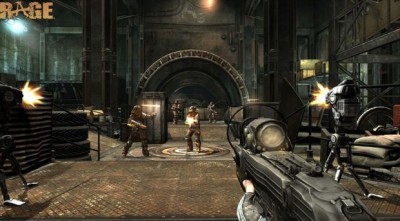Author’s Note: This interview has been edited for length and content, with intent to condense, while not rephrasing, points made within it.
As the industry begins to feel the first waves of the E3 effect, we took the opportunity to throw a few questions at Scott Steinberg, to get a professional perspective on new hardware and all of the issues surrounding the industry today. Mr. Steinberg is (among several thousand other resume credits) the founder of both Game Exec and Game Industry TV.
Elder-Geek: One of the biggest products at last month’s E3 was Microsoft’s Kinect. You have been highly publicized in your thoughts on the motion control platform having initial (but not long-lasting) success. With all the rumors surrounding the device’s price and capabilities, has you position on Kinect changed?
Steinberg: “Kinect is in an odd place as a product. Right now it offers a very casual experience with its software, but you have to be a hardcore player to own the system. And on top of that, they are asking for more money for the accessory. While titles like Kinectimals or Dance Central are promising for the casual demographic, I’m not sure if it’s the software needed to sell the device to the existing console owners. I am much more excited about the cross-media features, video chat and menu navigation and such.”
E-G: How many units do you see Kinect selling by the end of the 2010 Fiscal Year?
Steinberg: “A million units, for sure, it will get a lot of excitement initially. A lot of people will be excited to go “hands off” with the technology. However, I do not feel that they will be able to sustain the momentum without killer applications. It’s a hard fit to sell a casual system to a hardcore market, especially while we are trying to recover from a crappy economy.”
E-G: What would be that killer app?
Steinberg: “For the hardcore crowd, there is no single killer application, at least not that they have shown. Whether it is Halo or Forza Motorsport (and not just being able to look at your rims), things will have to actually work with ducking and shifting. First-Person Shooters can use the technology very effectively, but that’s a big challenge to developers. The single killer app is just going to be the ability to toss up digital conference calls and turn your living room into a meeting hub, it really shifts the game in terms of being a multimedia hub”
E-G: The direct competitor at the show in terms of new console hardware was the Playstation Move. Where does that stand in terms of the competition?
 Steinberg: “Sony’s trying to position the Move as the more advanced Wii; ‘you started with the Wii-mote, you’ve done that for a while, you are ready to advance’. Sony’s showed some casual and hardcore applications [at the show], and the same time it smacks of a solution looking for a problem. I don’t think a lot of people were excited for the [new] motion control wagon, they are kind of burnt out on the Wii. The Playstation Move is a tough sell: it’s a good piece of technology but there is no piece of software that makes you want to go out and buy it, not to say there isn’t a God of War coming down the pipeline. I don’t think that kind of intermediate level of gamer they are going for, between the casual and hardcore, really exists.”
Steinberg: “Sony’s trying to position the Move as the more advanced Wii; ‘you started with the Wii-mote, you’ve done that for a while, you are ready to advance’. Sony’s showed some casual and hardcore applications [at the show], and the same time it smacks of a solution looking for a problem. I don’t think a lot of people were excited for the [new] motion control wagon, they are kind of burnt out on the Wii. The Playstation Move is a tough sell: it’s a good piece of technology but there is no piece of software that makes you want to go out and buy it, not to say there isn’t a God of War coming down the pipeline. I don’t think that kind of intermediate level of gamer they are going for, between the casual and hardcore, really exists.”
E-G: On the handheld side, many say that the Nintendo 3DS stole the show, simply by being able to fulfill its glasses-less promise. Did you get a chance to see it?
Steinberg: “Nobody got much hands time on it, but the 3DS is impressive hardware. Not just for its selection of good quality software at launch, but for it being the most approachable version of 3D technology. Sony’s asking for glasses, and Nintendo comes out elegantly with the system’s full breadth of media potential. It has the ability to show movies, play games, and all without glasses. Doesn’t hurt with Kid Icarus and the Legend of Zelda: Ocarina of Time remake, it should be much more interesting than Sony’s solution.”
E-G: How do you compare the 3D between Sony and Nintendo? Which has the more preferable option?
Steinberg: “Playstation 3D is a very high-end consumer product, you have to buy a 3D-capable HDTV, you have to buy glasses, and – for new consumers – you have to buy a PS3. Nintendo is much more accessible and much more affordable, so it makes more sense in hectic travel sense, something you’ll feel comfortable having your kid take to the playground.”
E-G: Do you have an estimated price point for the 3DS?
Steinberg: “I suspect $249 at initial launch, with the ability to play movies and things making it easier to swallow for the everyday consumer. Keep in mind, they could price at $300, and it will still cheaper than buying a Bravia [Sony’s 3D-HDTV line].”
E-G: Moving on from the Big 3, one of the less highlighted events of the E3 was the mid-show launch of OnLive. With the industry split down the middle on the prospect of cloud streaming services, where do you stand?
Steinberg: “Cloud gaming is going to be an adjunct to current market. Not a lot of people will be switching over from consoles immediately, but it will attract a small and growing segment of the current market. And so it makes sense, it’s a very compelling proposition. Still, you will have to prove how well the system will work in the wild, how well will the graphics compare to high-end PC systems. We’ve seen demonstrations where the high-end games doesn’t quite hold up compared to the best PCs. For the business side, it’s about how quickly they can find as many partnerships as possible, and how fast they could push out the highest end software. There is still a lot of public, consumer, education that needs to go on before cloud computing takes off.”
E-G: What’s your Game of the Show?
 Steinberg: “If I had to pick, Rage from id Software. It stands to raise the bar for visual fidelity, although I’m not sure if gameplay will hold. It’ll definitely push the audio-visual boundaries of current games, but it’s not as impressive all-around compared to the rest of the show. But it surely stands to take the most chances when it hits the market. By in large, this year’s E3 was a predictable software show, very sequel oriented. This year was very hardware oriented, it happens from time to time.”
Steinberg: “If I had to pick, Rage from id Software. It stands to raise the bar for visual fidelity, although I’m not sure if gameplay will hold. It’ll definitely push the audio-visual boundaries of current games, but it’s not as impressive all-around compared to the rest of the show. But it surely stands to take the most chances when it hits the market. By in large, this year’s E3 was a predictable software show, very sequel oriented. This year was very hardware oriented, it happens from time to time.”
E-G: With comments coming in from both the analyst and developer side of the industry all saying that the current console life cycle will be over in a few years. When do you think will be getting new consoles, if ever?
Steinberg: “Microsoft and Sony are trying to eek out peripherals to extend their life cycle, and manufacturers are seriously trying to extend their promise for these to be 10 year systems, because from a financial standpoint they need to be. I think we will hear an inkling of new consoles much sooner on the portable front before we get a new home console, a PSP2 much sooner than a PS4. From a developer’s standpoint, its in everybody’s interests, including shoppers, to keep the current software. We are at the point of a life cycle where developers are starting to eek out the last potential of the current hardware, and they are stretched pretty thin. From a manufacturer’s standpoint they’ve sunk so much money into these consoles, they aren’t eager to roll out new products.”
E-G: Will these new consoles be focused completely on digital distribution?
Steinberg: “Not completely. We have a tremendous range of software products going from free to $60 at retail, so I think the current economy’s good; it is not in anyone’s interest to rock the boat, certainly not for the next few years, when everyone thinks the new consoles will come out. I think the new generation of consoles will, while certainly not downplaying it, but they will definitively push the digital side of things.”
E-G: With TellTale’s new Pilot program and Xbox Live’s Indie Marketplace, what is the future of independent development going to look like?
Steinberg: “It is always a positive for more distribution channels [to be around] to get more games to the public at large. I think these programs are a benefit for developers to connect to their fans by enjoying the larger marketing benefits. You don’t need TellTale to sell your games, but it is nice to see publishers willing to experiment and take more risks on these issues; it draws more attention to them and raises sales, and it also inspires more independent developers to create games and get their name out. I think collectively, the ratio of indie-developed games will rise year over year continually. As this awareness spreads, it’s going to be good for the field as a whole. Game creation is not an easy process, you will see a lot more people flocking to the indie field, but you aren’t going to suddenly see 80,000 games spring from the field.
[With these programs] People will see you don’t have to have a Ubisoft or EA backing you, and such a thought excites people and gets them to try new things. It’s an advantage for the big publishers too. I think economically speaking, risks are becoming bigger, layoffs are getting more rampant, smart phones have become a huge competitor. A lot more people (whether by choice or serendipity) are forming new studios and developing independently, the pressure-cooker economy is a better initiative than the game pilots program. Any time an established entity is willing to throw themselves behind an indie label, the more the better.”
E-G: One of the most complicated issues facing the industry is digital rights management. Everyone seems to have their own solution to the problem, what’s yours?
Steinberg: “A little common sense here goes a long way; if you buy a game you have the rights (within reason) to do with it whatever you want. If you release a game, you should expect people to buy and not steal it. Not everyone has $50 to spend, especially with it being free on the internet. Someone determined to get a title will crack any DRM solution that publishers put forth. Why make it such a problem for everyone else? Create an online field, something that requires regular authentication, and give the people who purchase the game extra content in reward. If I’m going to steal your game, I’m going to find a way, but I’m in the minority. I’m not saying it’s the right thing, but that’s the way of the world. At the same time if I have incentive – I can go and buy the copy and go online and get all this free stuff – I might go and try the purchase method; it’s the carrot and the stick method. If you put such heavy copy protection and makes the gaming experience even worse, how are you as a developer doing yourself any favors? If you create a system strong enough to deter casual pirates (those that won’t jump through 50 hoops to get a free copy), you cut out the majority of your loss. They’ve been doing this since the Commodore 64, and I can’t say things have changed much, many developers have become a bit more erratic. I don’t think punishing your customers is a way to go.”


Great stuff! A definite worthwhile read.